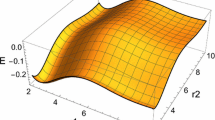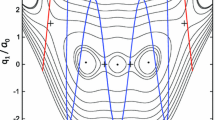Abstract
Valley-ridge inflection points (VRI) on the potential energy surface for the ring opening of the cyclopropyl radical to allyl radical are determined using the tool of Newton trajectories (Quapp and Schmidt in Theor Chem Acc 128:47, 2011). VRIs play a role in the understanding of bifurcating reactions. The region where the bifurcation takes place is usually governed by a VRI point. For this important ring opening, the knowledge of the VRI point after the transition state was demanded some years ago (Mann and Hase in J Am Chem Soc 124:3208, 2002). Because the transition state is not symmetric, also the steepest descent from the transition state is not along a symmetry axis, and in such cases the steepest descent can fail the VRI point. That is the case here, indeed, though the pathway of the steepest descent goes near to a VRI point downhill. However, an electronic intersection seam disturbs the relations. The exploration of the notorious curvilinear potential energy surface of this ring opening has delivered some further VRI points, which are reported. They give a frame for possible ring-opening channels including the conrotatory case.

























Similar content being viewed by others
References
Mezey PG (1987) Potential energy hypersurfaces. Elsevier, Amsterdam
Heidrich D (ed) (1995) The reaction path in chemistry: current approaches and perspectives. Kluwer, Dordrecht
Fukui K (1970) J Phys Chem 74:4161
Hofmann DK, Nord RS, Ruedenberg K (1986) Theor Chem Acta 69:265
Sun J-Q, Ruedenberg K (1993) J Chem Phys 98:9707
Quapp W (1989) Theor Chem Acta 75:447
Williams IH, Maggiora GM (1982) J Mol Struct 89:365
Quapp W, Hirsch M, Heidrich D (1998) Theor Chem Acc 100:285
Quapp W, Hirsch M, Imig O, Heidrich D (1998) J Comput Chem 19:1087
Quapp W (2001) J Comput Chem 22:537
Hirsch M, Quapp W (2002) J Comput Chem 23:887
Anglada JM, Besalú E, Bofill JM, Crehuet R (2001) J Comput Chem 22:387
Bofill JM, Anglada JM (2001) Theor Chem Acc 105:463
Crehuet R, Bofill JM, Anglada JM (2002) Theor Chem Acc 107:130
Quapp W (2004) J Molec Struct 695(-696):95
Valtazanos P, Ruedenberg K (1986) Theor Chim Acta 69:281
Bofill JM, Quapp W (2011) J Chem Phys 134:074101
Quapp W, Schmidt B (2011) Theor Chem Acc 128:47
Schmidt MV, Baldridge KK, Boatz JA, Elbert ST, Gordon MS, Jensen JH, Koseki S, Matsunaga N, Nguyen KA, Su S, Windus TL, Dupuis M, Montgomery JA Jr (1993) J Comput Chem 14:1347
Gordon MS, Schmidt MW (2005) In: Dykstra CE, Frenking G, Kim KS, Scuseria GE (eds) Theory and applications of computational chemistry, the first forty years, chap 41. Elsevier, Amsterdam, p 1167 (GAMESS Version 2007)
Quapp W (2010) web-page: http://www.math.uni-leipzig.de/~quapp/SkewVRIs.html
Woodward RB, Hoffmann R (1965) J Am Chem Soc 87:395
Woodward RB, Hoffmann R (1969) Angew Chem Int Ed Engl 8:781
Clark DT, Adams DB (1971) Nature Phys Sci 233:121
Olivella S, Solé A, Bofill JM (1990) J Am Chem Soc 112:2160
Arnold PA, Carpender BK (2000) Chem Phys Lett 328:90
Mann DJ, Hase WL (2002) J Am Chem Soc 124:3208
Mann DJ, Halls MD (2002) Phys Chem Chem Phys 4:5066
Aguilar-Mogas A, Giménez X, Bofill JM (2010) J Comput Chem 31:2510
Lucas JM, de Andrés J, Albertí M, Bofill JM, Bassi D, Aguilar A (2010) Phys Chem Chem Phys 12:13646
Pulay P, Hamilton TP (1988) J Chem Phys 88:4926
Bofill JM, Pulay P (1989) J Chem Phys 90:3637
Arnold PA, Cosofret BR, Dylewski SM, Houston PL, Carpenter BK (2001) J Phys Chem A 105:1693
Yarkony DR (1996) Rev Mod Phys 68:985
Martinez TJ (2010) Nature 467:412
Holtzhauer K, Cometta-Morini C, Oth JFM (1990) J Phys Org Chem 3:219
Dong F, Davis S, Nesbitt DJ (2006) J Phys Chem 110:3059
Hirsch H, Quapp W, Heidrich D (1999) Phys Chem Chem Phys 1:5291
Quapp W, Hirsch M, Heidrich D (2004) Theor Chem Acc 112:40
Pechukas P (1976) J Chem Phys 64:1516
Thompson JMT, Stewart HB, Ueda Y (1994) Phys Rev E 49:1019
Robb MA, Olivucci M (2001) J Photochem Photobiol A 5373:1
Longuet-Higgins HC, Abrahamson EW (1965) J Am Chem Soc 87:2045
Schultz T, Clarke JS, Gilbert T, Deyerl H-J, Fischer I (2000) Faraday Discuss 115:17
Hratchian HP, Schlegel HB (2004) J Chem Phys 120:9918
Voth GA, Hochstrasser RM (1996) J Phys Chem 100:13034
Knyazev VD (2002) J Phys Chem A 106:8741
O’Neal D, Taylor H, Simons J (1984) J Phys Chem 88:1510
Sun L, Song K, Hase WL (2002) Science 296:875
Debbert SL, Carpender BK, Hrovat DA, Borden WT (2002) J Am Chem Soc 124:7896
Ammal SC, Yamataka H, Aida M, Dupuis M (2003) Science 299:1555
López JG, Vayner G, Lourderaj U, Addepalli SV, Kata S, deJong WA, Windus TL, Hase WL (2007) J Am Chem Soc 129:9976
Hirsch M, Quapp W (2004) J Mol Struct 683:1
Hirsch M, Quapp W (2004) J Math Chem 36:307
Quapp W (2009) J Theor Comput Chem 8:101
Acknowledgments
Financial support from the Spanish Ministerio de Ciencia y Tecnologia, DGI project CTQ2008-02856/BQU and, in part from the Generalitat de Catalunya projects 2009SGR-1472, is fully acknowledged.
Author information
Authors and Affiliations
Corresponding author
Electronic supplementary material
Below is the link to the electronic supplementary material.
Rights and permissions
About this article
Cite this article
Quapp, W., Bofill, J.M. & Aguilar-Mogas, A. Exploration of cyclopropyl radical ring opening to allyl radical by Newton trajectories: importance of valley-ridge inflection points to understand the topography. Theor Chem Acc 129, 803–821 (2011). https://doi.org/10.1007/s00214-011-0938-4
Received:
Accepted:
Published:
Issue Date:
DOI: https://doi.org/10.1007/s00214-011-0938-4




